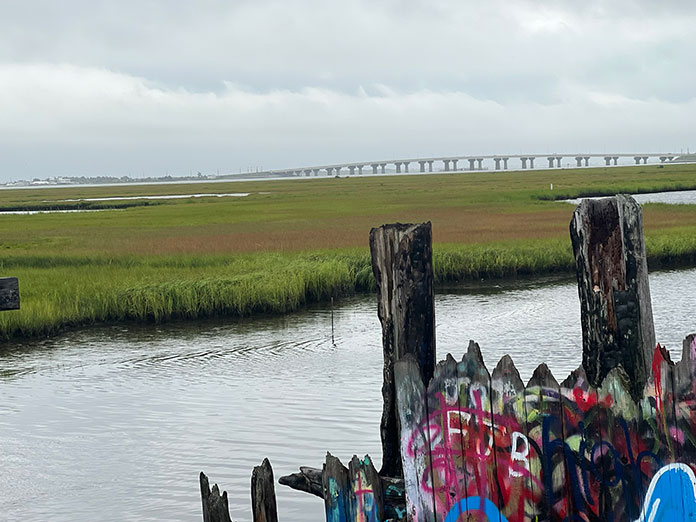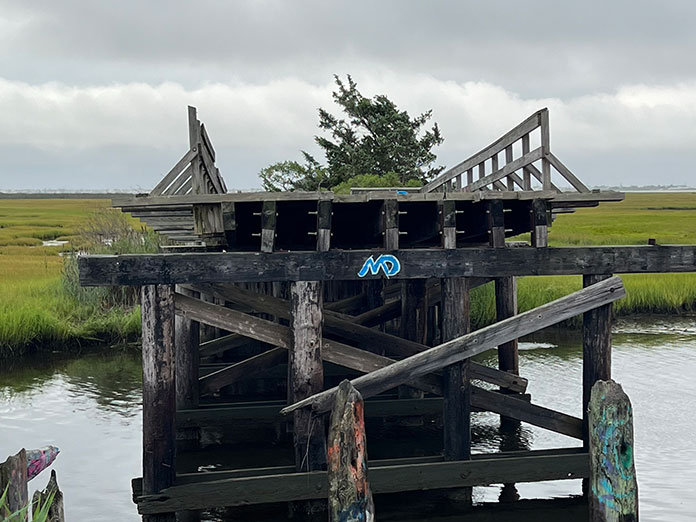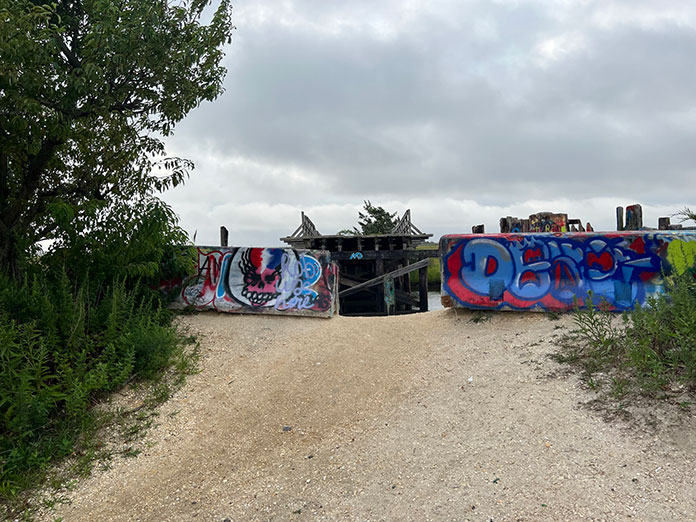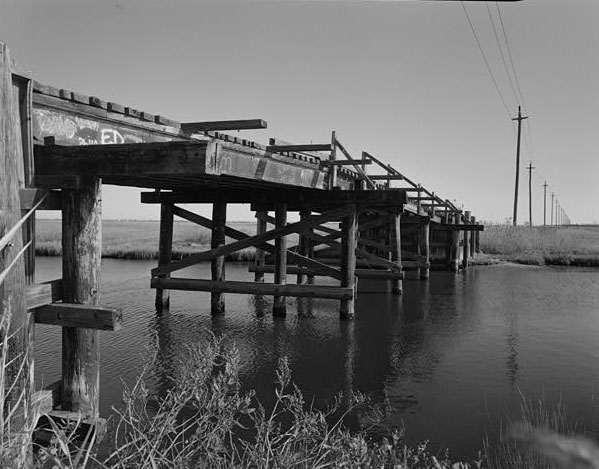
MANAHAWKIN – A path that leads to nowhere may seem like a riddle, but in Manahawkin, it’s a reality that has captivated locals and visitors alike. In truth, the Road to Nowhere abruptly stops, culminating at the broken Bridge to Nowhere.
The construction of the bridge itself has sparked numerous stories about its inception. The folklore includes tales of a housing development halted by the insurgence of harsher environmental regulations.
Another story suggests the Bridge to Nowhere played a vital role in shortwave radio communications in World War II as a connection to an array of an old AT&T receiving station.
Finally, there’s the theory suggesting that the bridge was originally built to offer an additional route for travelers moving between the mainland and Long Beach Island.

Far more intriguing comes from information collected from the Library of Congress in its “Historic American Buildings Survey, Engineering Record, Landscapes Survey.” Notes indicate that the bridge was initially constructed in 1871 and again in 1990.
Regardless of its history, the area represents a captivating tapestry of wetlands and estuarine landscapes – a haven for kayakers, crabbers, anglers, and bird watchers. One of the ways to explore this area is by turning right onto Stafford Avenue from Route 72 East.
Life During Wartime
Standing at the spot where the Road to Nowhere ends, the Bridge to Nowhere comes into view, separated by a short stretch of water. Looking northward beyond the sea marshes, rows of telephone poles become visible in the distance.
Local historian and writer Gretchen Coyle suggests a compelling connection between these poles and the Bridge to Nowhere.
Coyle’s investigation revealed that AT&T established several sites within the New Jersey marshlands during the late 1920s and 1930s. The research indicated that the strategically positioned areas were crucial shortwave radio transmission and receiving stations, facilitating ship-to-shore communication and direct links to Europe.
The location where the poles stand has undergone a few name changes and is currently recognized as the Edwin B. Forsythe National Wildlife Refuge. The site once featured more than 131 poles and eight antennae. It operated in conjunction with the shortwave radio station WOO, situated 15 miles north of Good Luck Point in Berkeley, where a building still stands.

Communications facilitated as a result of these transmissions are believed to have played a crucial role in coordinating the Normandy Invasion in 1944. They were also instrumental in broadcasting Voice of America worldwide.
Based on Coyle’s findings, the Bridge to Nowhere functioned as a means for vehicles to transverse the Cedar Creek Tributary and access the network of AT&T poles.
Unfinished Development
Some believe the bridge’s original purpose was to kickstart a lagoon community like the Beach Haven West community. This idea came to life in the 1950s, just before environmental rules got stricter.
According to this tale, the developer abandoned the bridge project after hitting a roadblock. Obtaining approvals to construct homes in the wetlands overladen with endangered species proved to be an insurmountable challenge.
Bridge To LBI
Hardly anyone would argue that the only way to cross the waterways between Stafford and LBI presents a possible nightmare. The issue isn’t solely about traffic backing up for hours on the Causeway Bridge, officially named the Dorland J. Henderson Memorial but more commonly referred to as the Manahawkin Bay Bridge.
Even those with the mildest sense of unease might zero in on the evident concern: What if the bridge collapses or a state of emergency necessitates a mass island evacuation? The idea of a second bridge simply appears to be a practical solution.
The problem? There’s absolutely no documented proof that the “Bridge to Nowhere” was constructed with the intent of an intercoastal connection.

Share Of Good and Bad
The tranquility enveloping the Bridge to Nowhere presents a scene that any photographer would find captivating. Those inclined to cast a fishing rod are bound to reel in a remarkable catch, just like those who venture in with crabbing nets.
For bird lovers, the area provides a heavenly view from the skies above. According to a website called ebird.org, visitors have spotted close to 300 separate species over the years. These include seven different variants of owls, assorted songbirds, and more than half a dozen hawks of varied types.
When it comes to winged creatures, at least one doesn’t seem to elicit any particular affection from guests in the area. Green-headed flies enjoy the marshlands and the taste of sweet human flesh.
German Georgieff, Chief Naturalist within the Ocean County Parks system, has provided tours to the area for many years and offered some further insight.
“The freshwater streams to the salt marsh have a dam across that creates freshwater vegetation to grow in the middle,” shared Georgieff. “That gives the wildlife, mainly the egrets, ducks, and geese more of a variety of food because there’s freshwater vegetation in addition to the saltwater vegetation nearby.”
Georgieff explained that the north side of the Road to Nowhere is part of the Edwin P. Forsythe National Wildlife Refuge. On the left side, New Jersey Wildlife Management areas control the property and has public areas designated for hunting and fishing and are purchased with hunting and fishing license money.
“It’s not just a popular area for bird watchers,” Georgieff pointed out. “It’s also for waterfowlers who like to pursue duck and goose.”
Unfortunately, the secluded area has also drawn its share of problems. Graffiti mars the surroundings, and stories abound of gatherings involving drug use and devil worship. Additionally, the spot has gained notoriety as a meeting place for casual sexual encounters, with a recent incident leading to an arrest when an older man made inappropriate advances towards another individual.
Two fires that were intentionally set at the bridge hastened its deterioration, prompting authorities to choose not to undertake its reconstruction.
Sadly, the most tragic incident linked to the Road and Bridge to Nowhere revolves around a young woman losing her life. She was trapped inside a submerged car, an incident that occurred many years ago.
Still No Answers
As the Bridge to Nowhere remains a broken bridge, its actual origin remains a true mystery.
From the unexpected twist of a halted housing development amidst strict environmental regulations to its wartime radio role, this bridge stands as a testament to the evolving narratives of the past.
The Road to Nowhere leading to the Bridge to Nowhere actually reigns as an unsolved riddle with a host of contradictions. Its picturesque serenity underscores human tragedy and destruction at the hands of misguided humans.
In the heart of Manahawkin, the Bridge to Nowhere stands not merely as a physical structure but as a testament to the intertwining threads of humanity’s past, present, and obscurities that continue to beckon from the road less traveled.







